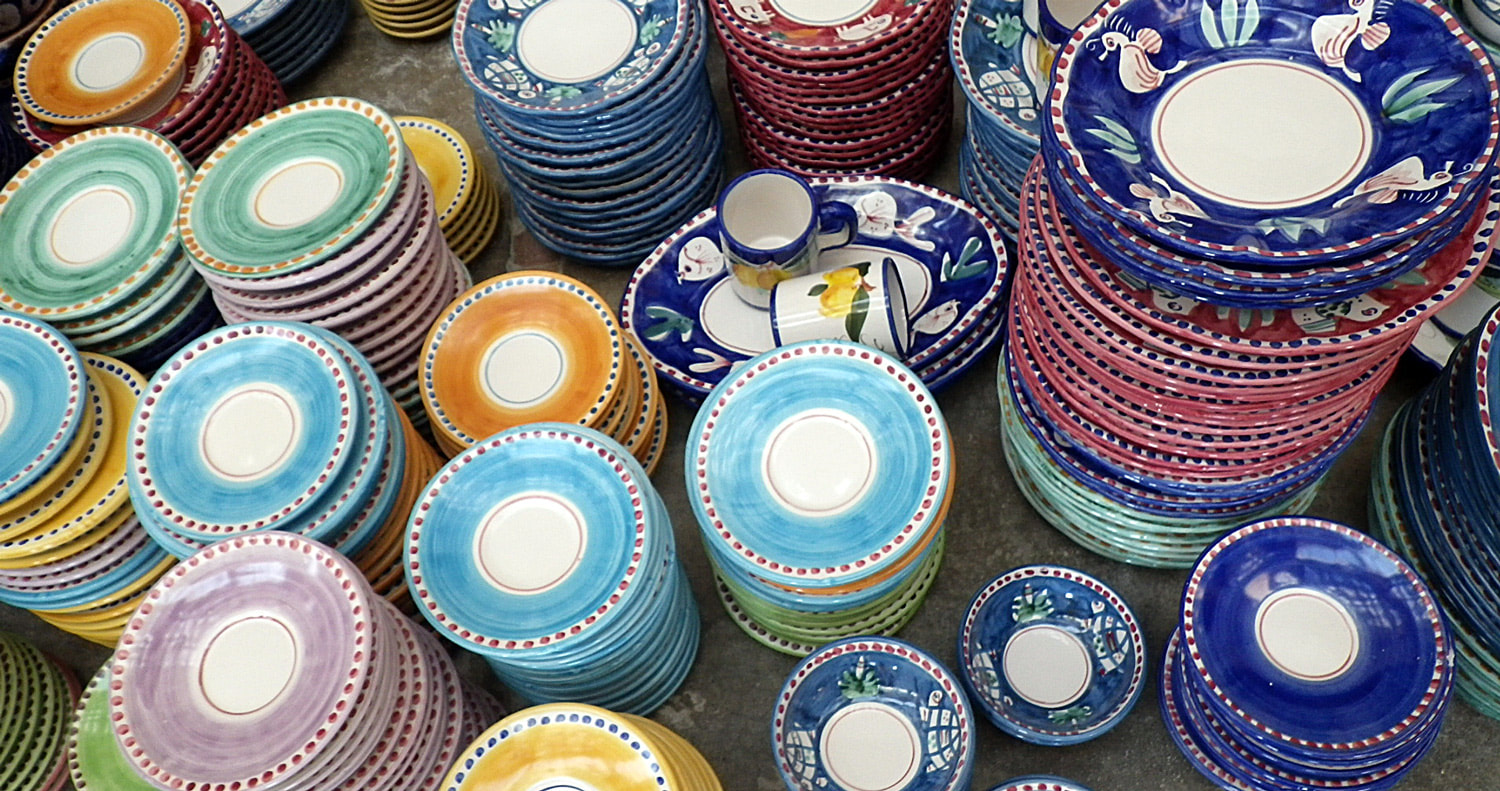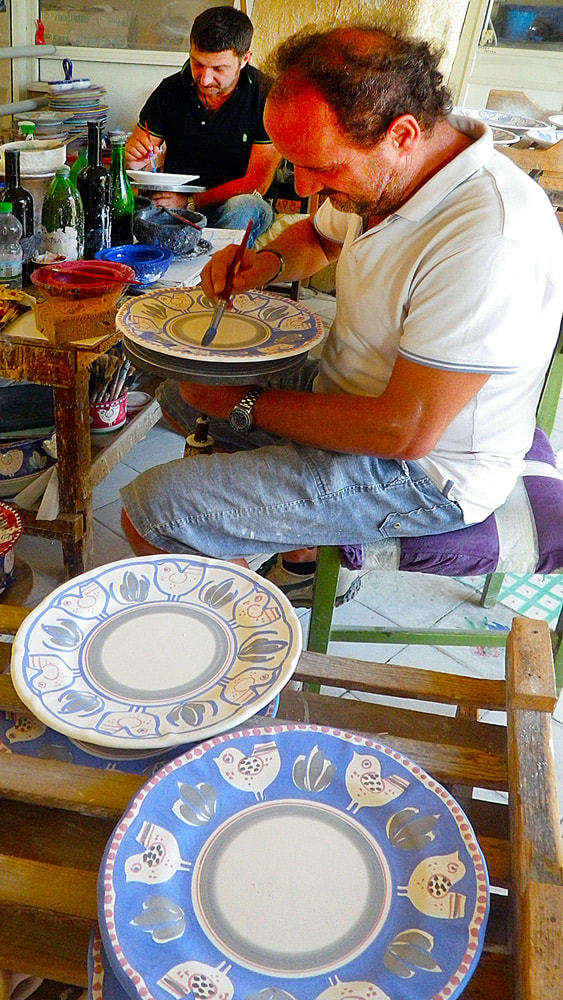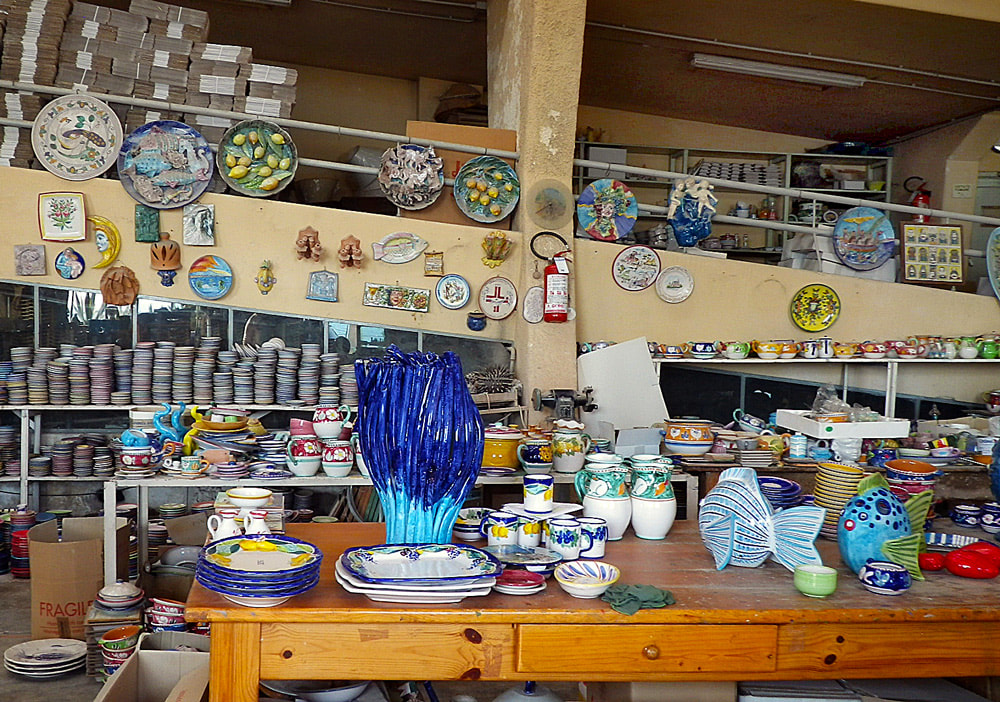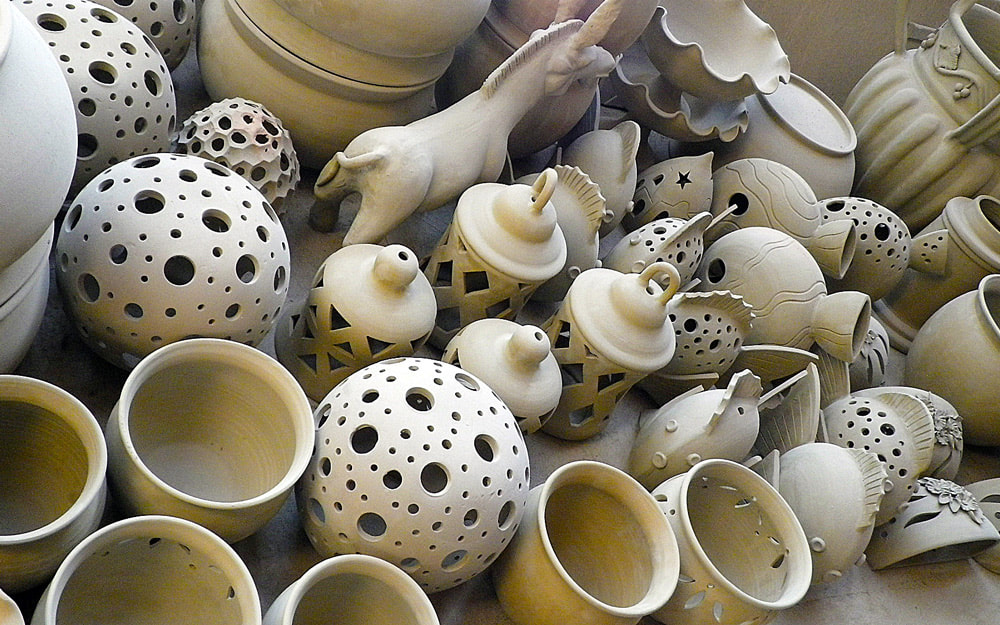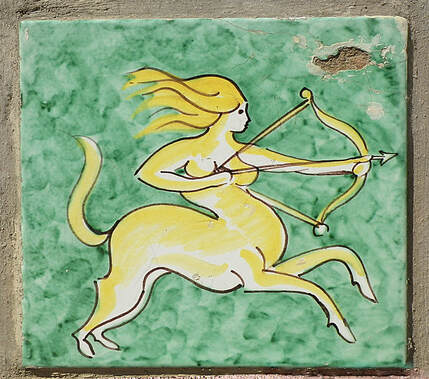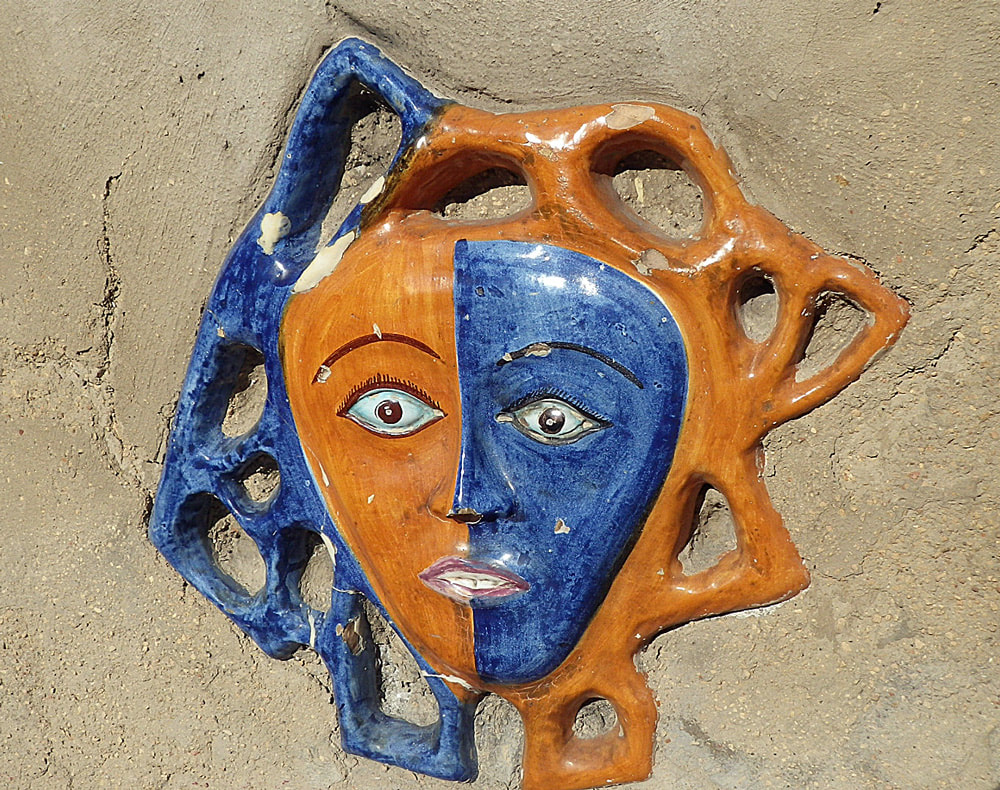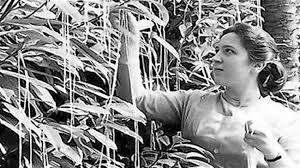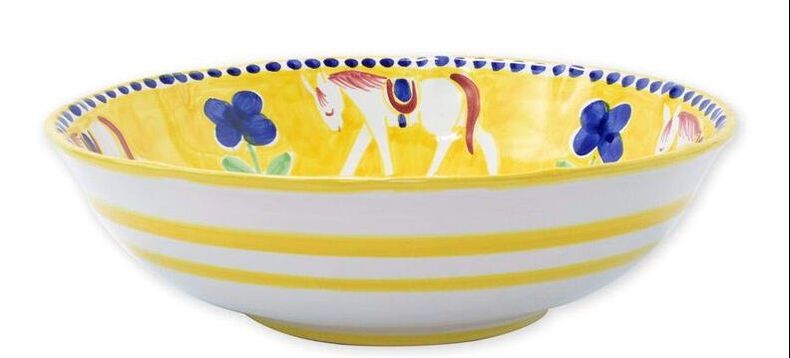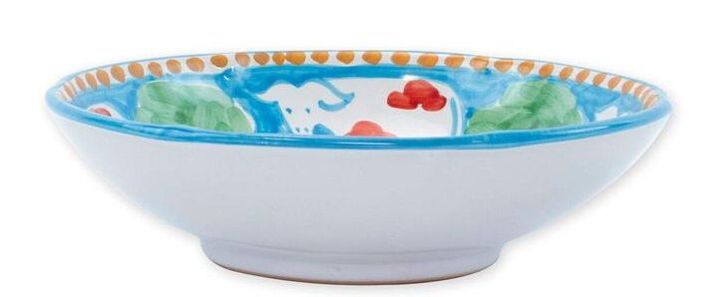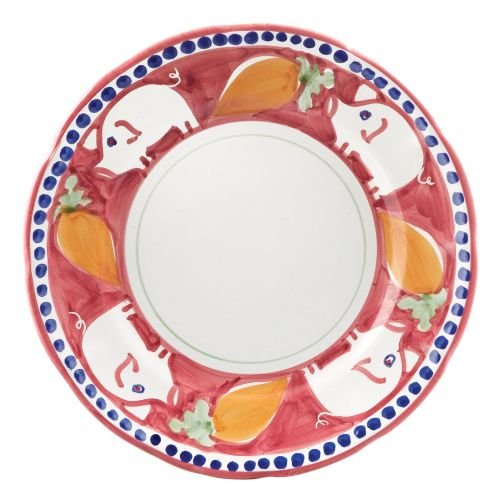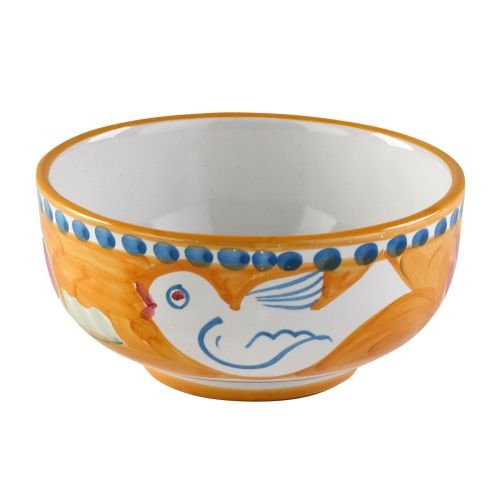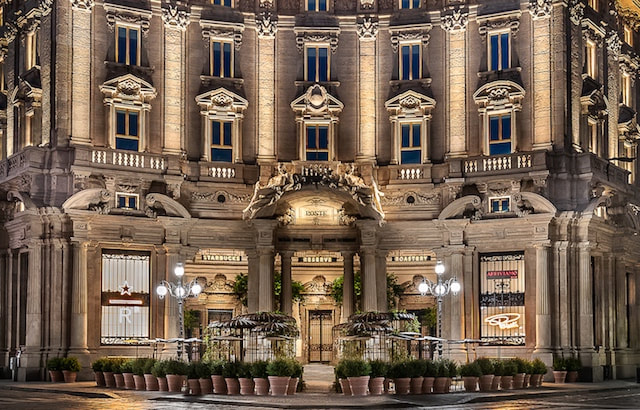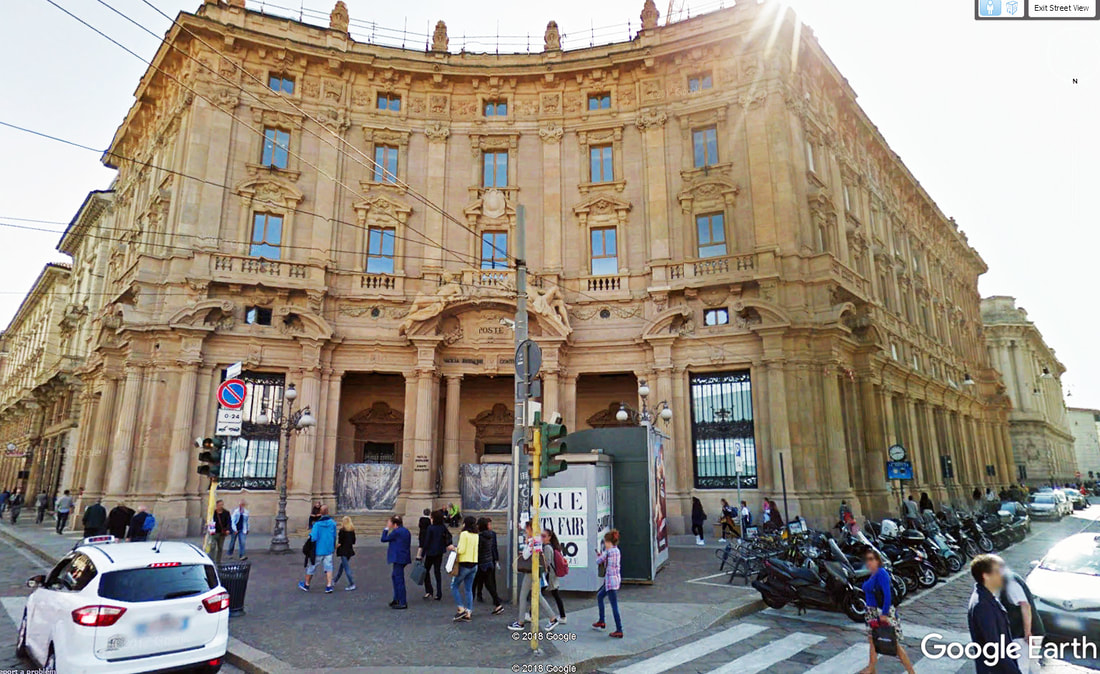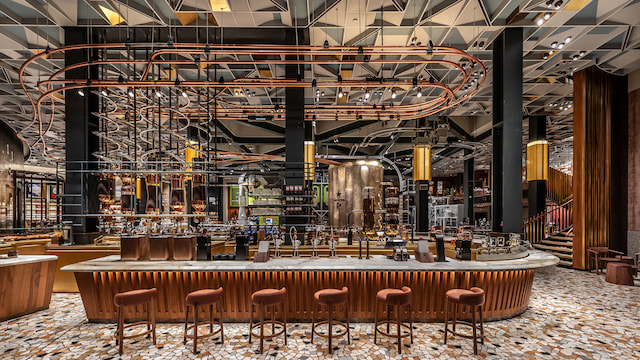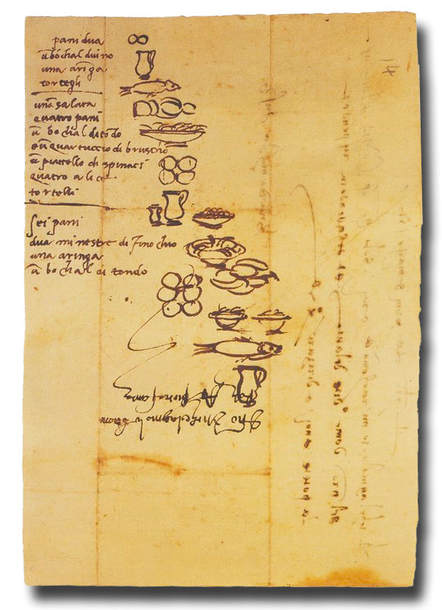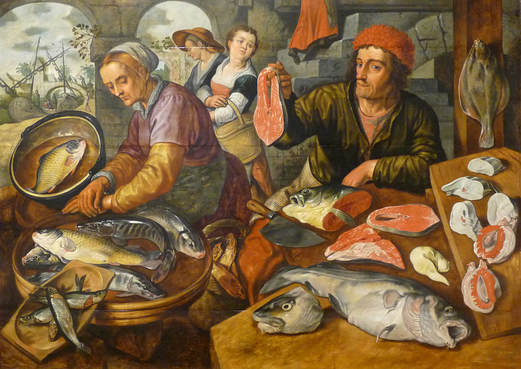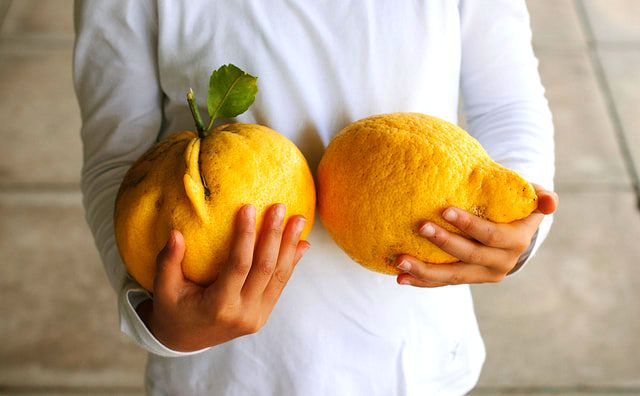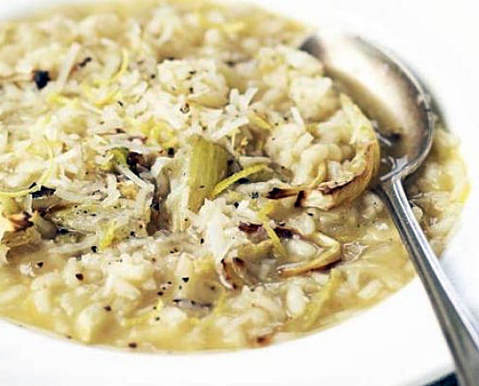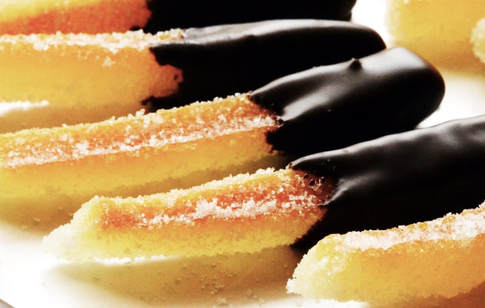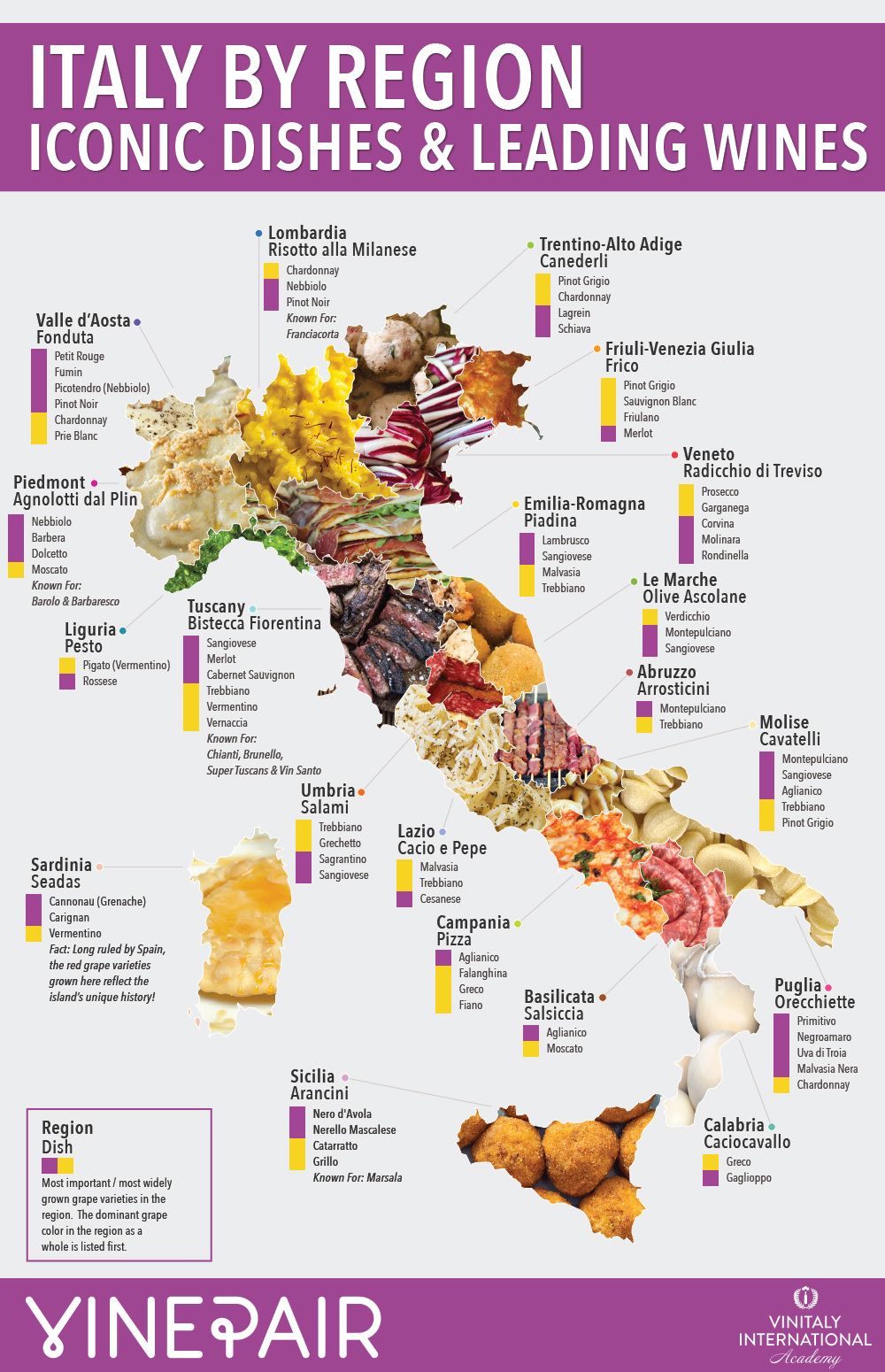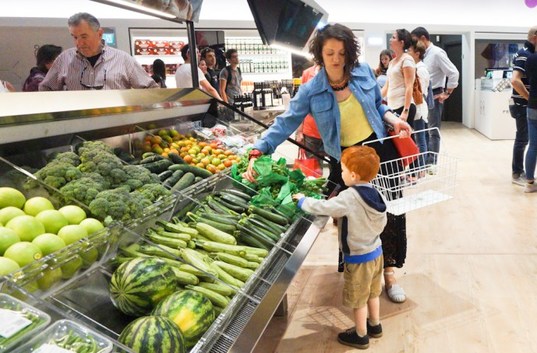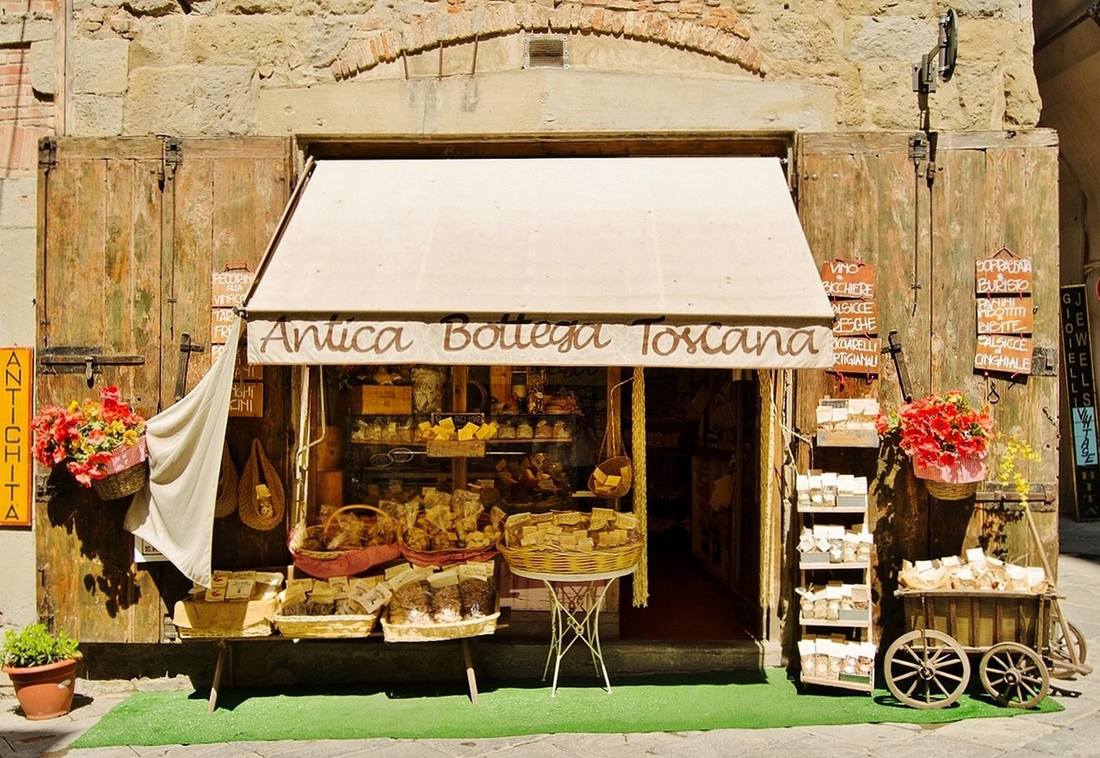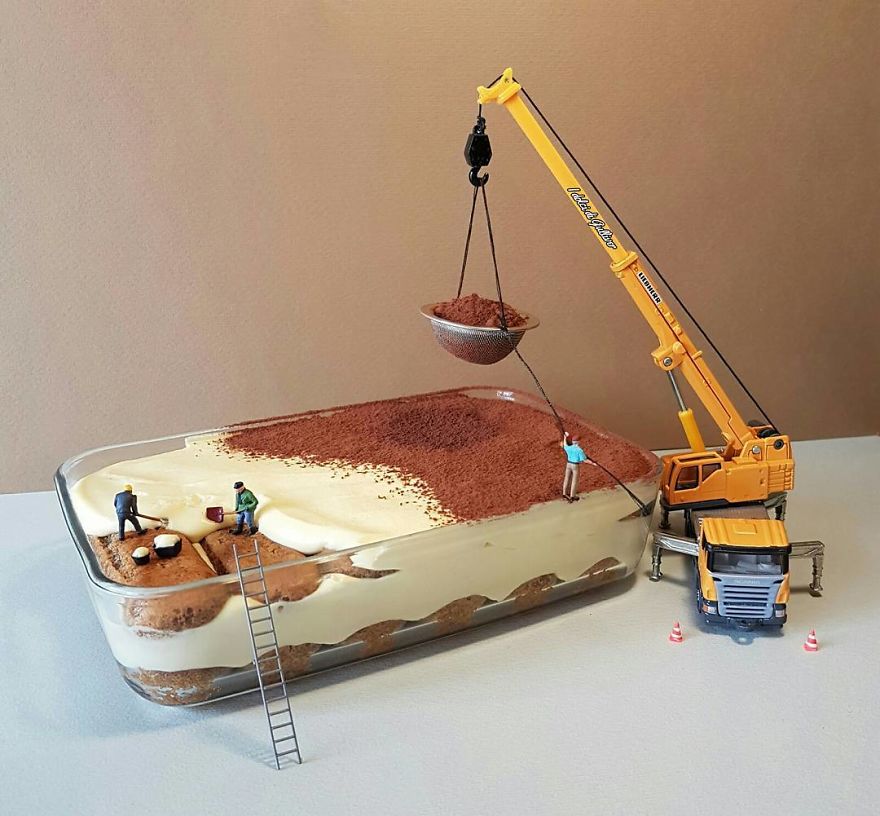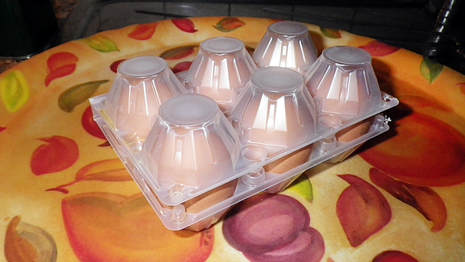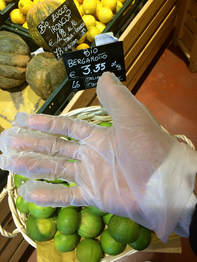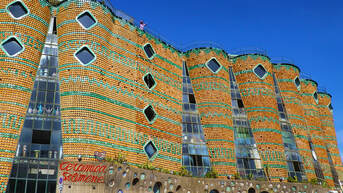 When we spent some time on the Amalfi Coast, one of our goals was to visit "the" ceramics town--Vietri sul Mare, just west of Salerno. One of its must-see places to visit was the amazing Ceramica Artistica Solimene, one of the most iconic artisan shops for Vietri ceramics. Rather than the geometri, Renaissance designs of other ceramic design shops, Solemene's designs are childlike, with free-handed strokes and creatures and colors of the life along the Amalfi Coast... fish, octopus, pigs, chickens and donkeys. The building which houses the "factory" (if you can call it that, since all the ceramics are made by and painted by hand), is itself a work of art, commissioned by Vincenzo Solimene and completed in 1954. Architect Paolo Soleri designed this masterpiece of architecture, a mid-century modern homage to ceramics, with its inverted, cone shaped exterior covered with terracotta discs. 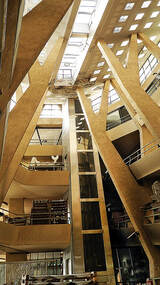 The interior houses a sales area on the first floor open to the skylights on the roof, with a ramp that spirals upward (no stairs, but there is a small elevator) to different levels where the clay is formed, sculpted and then painted. The spiraling design is similar to modern parking garages. Chain smoking artisans welcome visitors and will even give short lessons on their techniques (our son--then 11--was shown how to attach a handle to a cup). Visiting the Solimene factory can be considered the highlight of spending some time in Vietri sul Mare's ceramics district--there are scores of ceramic shops within a few blocks. 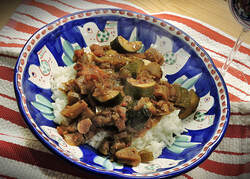 Our own Gallo pattern serving my ratatouille Our own Gallo pattern serving my ratatouille The family business has been creating ceramics for more than a century and has produced tableware, garden ceramics and pots, sculptural pieces, floor and wall tiles--all worked and painted entirely by hand, using a combination of modern and ancient techniques, such as the potter's wheel. Their tableware is food safe (they utilize lead-free glazes) and can even withstand dishwashers. In our own Pennsylvania villa, we serve our meals on Solimene ceramics. So far, in about 5 years, no chips--just compliments. --Jerry Finzi Random pieces decorate the outside of the Solimene building On Amazon...
Calling all Milanese! Attenzione a tutti i Milanesi! The new Starbucks is opening today on Piazza Curdusio in Milano! The location is in the old post office... Please... visit the store, order one of their "coffees" and perhaps shoot a video of your visit and post it here on GVI... Tell us what you think about the "Starbucks Experience". Take photos of their menu and prices--and their giant sized offerings. Are the high prices (and high sugar & fat content) really worth a few couches and free WiFi?
GVI wants to know, and will include your impressions in an upcoming article. Let's really take a look to see if Italians really want Starbucks in the land of Moka pots and espresso. You can contact us here, or send us email via our Grand Voyage Italy Facebook page. --GVI For further reading: Will Starbucks Make it in Italy, Home of the Quick, Tiny Espresso Shot? Did you ever wonder about the everyday life of Renaissance Masters, like Michelangelo? Did you wonder if they took long walks or picnics? Did they go to the local taverns to kick back a few brews and relax with the guys? Did they attend sporting events or shop for bargains at the local flea market? How about their food? What did they eat and how did they do their shopping? Well, we can actually tell from this grocery shopping list written by Michelangelo himself in the 16th century. He ate anchovies, bread, two fennel soups, a herring (un aringa), four anchovies, tortelli, and wine (“un bocal di vino”), among other things. He drew the list as pictograms because his servant was illiterate. He would tell him what he wanted, "get the big loaf of bread, not the small one", but also sketch it so the servant could look at the images to refresh his memory while at the market. Experts say the list is for three separate meals. He drew bread rolls as simple circles--an easy shape for his servant to remember meant - bread. For another meal, he wanted two rolls but for another, six. The herring is sketched by itself, and bowls are filled with salad and anchovies. Two dishes of stewed fennel are shown side by side (perhaps he wasn't dining alone?). For the wine, he drew a small wine carafe next to a larger one--perhaps two types, one being an after dinner, sweet wine? The tortelli (tortellini) pasta were not drawn at all. Perhaps his servant's wife made them, something he obviously would never forget if the Master asked for some. Since the letter on the other side of the list was dated March 18, 1518, the meatless menu would make sense falling during the Lent period of fasting. Michelangelo couldn't eat meat, so it was bread, fish and veggies. Still, for its day, this was a nobleman's menu... Michelangelo was anything from a starving artist.
During this same year, Michelangelo had ordered many of his notes and sketches to be burned--the Renaissance method of shredding documents. It's amazing that this little take-out order managed to survive at all. This grocery list is archived at the Florence museum Casa Buonarroti, where one can find many of the artist’s handwritten notes, doodles and sketches. --Jerry Finzi 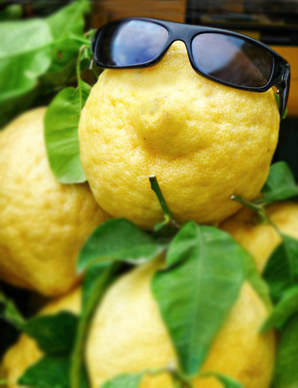 by Jerry Finzi While exploring the villages of the Amalfi Coast, Voyagers are certain to notice that the lemons there are larger than they are used to. They are sure to come across the Sfusato lemon (about two to three times the size of a supermarket lemon) and will be further shocked when they are confronted with the giant-sized, Cedro Citron variety of lemons. They are beastly looking things, with a pebbly surface, strange shapes with a large nipple at one end, and are often as big as your head! 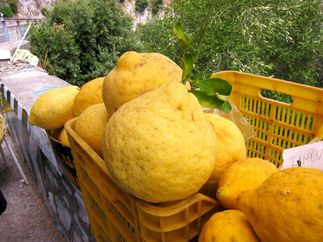 Cedri are primarily found in Italy, from the Italian Riviera down to the Amalfi Coast, though they are occasionally spotted in France, Isreal and even exported to Britain. There are three different citron types: acidic, non-acidic and pulpless. Of the different cultivars, the acidic Diamante is more common in Italy. Cedro citrons are usually up to three to four times the length of common lemons and can measure between 10 and 15 inches in diameter. They can weight up to 3-4 pounds each. The pebbly surface ripens from green to a bright yellow--both colors can be harvested, the peak season being fall and winter. Most--about 70%--of the lemon is white pith from 2-5 inches thick with a soft texture and almost sweet lemony fragrance. In its center is a small amount of segmented pulp with a few pale seeds. This lemon is fairly dry and not used for its juice and the taste is milder than a common lemon. 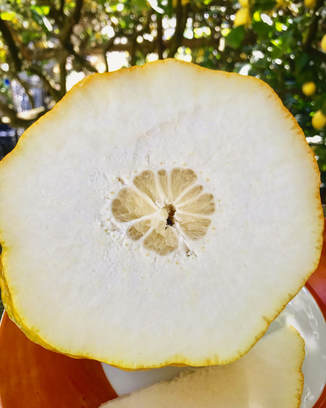 The pith can be eaten raw or cooked: in salads, atop bruschetta, in jams and preserves, in risotto or pickled. The rind of this citron is very aromatic and a bit sweet, and is used to produce "citron", or candied lemon (used in Italian celebration breads and cakes, like panettone). Some claim it can be a remedy for hangovers, coughs and indigestion. Since the Renaissance, the oils from the skin have also been used in perfumery and cosmetics due to their delicate and fragrant scent. If cooking while in Italy (or if you can get some cedri at home), try these recipes: Risotto alla Sorrento with Fennel and Sage 1 Cedro lemon 1-1/2 cups rice for risotto (Carnaroli, Vialone Nano or Arborio) 1-1/4 cups freshly grated parmesan 1 tablespoon unsalted butter, plus another tablespoon to finish 4 tablespoons Extra virgin olive oil 1 head of finoccio (bulbing fennel) - finely diced 3 stalks celery - finely diced 1 cup white white Vermouth 1 quart chicken stock 4 large julienned sage leaves (or 1/2 teaspoon dried-crushed) Sea salt and freshly ground black pepper to taste Directions
Candied Chocolate Cedro Strips Recipe (A great holiday snack) 1 - 2 pound cedro 1 cup sugar 1 pint water 3-5 ounces bitter sweet chocolate
You can store these in an airtight container and serve at the end of a meal with fruit, nuts, biscotti and espresso. © GVI 2018 You might also be interest in:
When Life Gives Them Lemons, Italians Make Limoncello Amalfi Lemon and Chicken Pasta Lemon and Turkey Pasta with Prosecco The setting: a small and friendly supermarket in a old sleepy town in Italy
The characters: Serena and the staff at supermarket Il giovane cassiere, all’entrata del supermercato: “Buongiorno!” The young cashier, at the supermarket entrance: “Good morning!” Serena: “Buongiorno!” Poi, parlando tra sé e sé: “Allora, vediamo la lista della spesa: pere, uva, funghi…” Serena: “Good morning!” Then, talking to herself: “Right, let’s have a look at the shopping Dopo aver scelto e pesato le verdure, Serena controlla ancora la lista: “Semolino. Dove l’hanno messo?” Poi, vedendo Enzo, il manager e tuttofare del supermarket, gli chiede: “Ciao Enzo! Dov’è il semolino?” Having chosen and weighed the vegetables, Serena checks the shopping list once more: “Semolina. Where have they put it?” Then, having seen Enzo, the manager and handyman of the supermarket, she asks him: “Hi Enzo! Where is the semolina?”list: pears, grapes, mushrooms…”.... Click for to Read More... 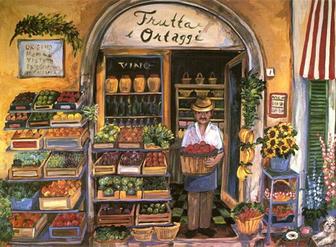 Specialty Stores Alimentari Small, neighborhood grocery store. They are everywhere and they are charming and helpful. Everything from toilet paper, water, sodas, wine (under 5 Euros!), produce, breads, cheeses (cut to order), bottled tomato sauce (pilati), salty snacks and biscotti (packaged cookies) and deli meats. The literal translation of alimentari is food. Everything you need to stock your rental villa's fridge or for a picnic is here. Panificio Bread baker (also, Panettiere, Panetteria or Forno--literally, oven), usually referring to a larger bread bakery. Forno Antico usually designates a bakery with older, historic, wood fired ovens that makes regional breads, but also may offer other things such as pizza, foccacia, tarts (savory or sweet) and pastries. Pasticceria Pastries, cakes (sometimes bread) Enoteca Wine shop (in our experience, mostly packaged tourist wines. Supermarkets and alimentari also have wine and liquors) Formaggeria Cheeses Frutta e Verdura Fruits and vegetables, Also Frutteria. Gelateria Ice cream (gelato and other frozen treats) Because many gelateria are open during riposa (the 2-3 hour lunch closure), we found many in smaller towns also offer light lunch snacks. Confetteria Confections, candies. Latteria Dairy (milk, butter, cheese). Also, Cremeria. Salumeria Cold cuts, cheese, salami, some canned goods (also called a Pizzicheria in some regions) Macelleria Fresh meat, salami, and sausage Rosticceria Take out and eat-in roasted foods, usually meats and vegetables Pescheria Fish Supermercato Supermarket. Some are national brands, like Carrefour, Coop, Crai, Essalunga, Auchun and Conad. These stores can be very large and located just outside town centers, while others are smaller. In cities you will see very small looking supermarket entrances, but they open up into much larger spaces. Bring a cloth or mesh bag and bag your own groceries. They charge for plastic shopping bags. Wear the provided plastic gloves when picking produce. Pizzeria Pizzeria. Many offer other dishes for lunch and dinner, and some are now offering pizza by the slice, or "al taglio". Bar Espresso or cappuccino for breakfast with pastries; sandwiches for lunch. Especially in smaller towns, this type of shop is the only place for you and your family to find something lunch. Most Italians (even working in restaurants) go home for 2-3 hours from 12-3pm for riposa, similar to a siesta. Tabacchi Tobacco products, lottery machines, various sundry items. Often combined as Bar-Tabacchi. (Unlike in U.S. cities, where "bottega" is specifically used to mean a local, small grocery store, in Italian, the word literally means "shop", and can have another word attached to describe what type of products it carries.) Osteria Tavern, often with simple food choices like sandwiches, pizzas, foccacia, especially during Serenissima, or Happy Hour. Also, Taverna or Trattoria. Birreria Micro Brewery. Panineria Sandwich (panini) shop. Panellari In Sicily, a street vendor or small shop selling chick pea fritters and sandwiches. Hamburgheria Just what it sounds like. 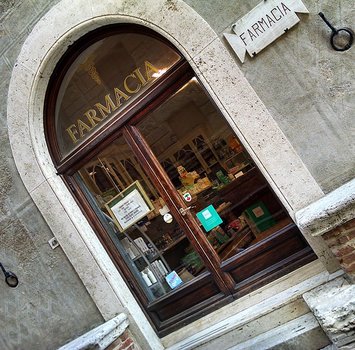 Non Food Stores (Note: the word Negozio means Shop.) Farmacia Pharmacy Edicola News-Magazine shop Drogheria Dry goods, canned goods, kitchen and household items. Even though it might sound like it, this is not a drug store. Ottico Optician Parrucheria Hair dresser (women) Barbiere Barber (men's) Lavasecco Laundry-Dry Cleaners (Drop-off service, often hard to find. As a local). Lavanderia a Gettone Laundromat (There are some chains, like Ondablu or Ecolava, but many are independent shops, often difficult to find. Once again, ask a local.) Mesticheria Hardware Sarto Tailor Libreria Book shop Cartoleria Stationers, office supplies, paper goods. Immobiliari Real Estate Scarperia Shoe store Sportivi Sports Cartoleria Stationary Store Vetreria Glassware, giftware. Gioielleria Jewelry Negozio di Abbigliamento Clothing shop Biancheria Undergarments, linens. Gioielleria Jewelry Store. Negozio di Giocattoli Toy shop. Also, Giocheria. --Jerry Finzi 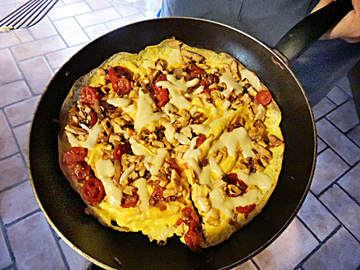 Returning from a Day Trip We decided that we were going to pick up supplies to cook with tonight after our trip to Florence and Fiesole. We tried to look for signs for a Coop supermarket or an alimentari (grocery store), but no signs and the only alimentari on the way back to Mormoraia was closed (at 5pm on a Saturday afternoon?), so we pulled on the side of the road and asked our GPS (Tommy) where the nearest one was. Niente closer that 20 miles... at least that's what he says. I don't trust him totally. After all, besides sounding a bit robotic, his accent is pure American! How much can he possibly know about local shops? He's just a tourist--just like us! So I figured that nearby San Gimignano must have an alimentari outside the historic walls... so we set course... 8 minutes away. We found one! A nice one too. Paper towels to use as napkins, cleanup and to clear my clay dusted rear window... eggs... sliced tachina (turkey)... brasciola (very thin sliced salt cured beef)... little tomatoes... onion... snacks... drinks...butter... half loaf of bread. We were set for dinner and breakfast--or so we thought. 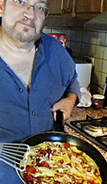 Another side hassle was that we were so chatty with the prospect of a home cooked meal combined with our friend Tommy not calling out turns for some reason as he usually does... we kept missing the turn-off out of town--four times! Sigh. (Our family travel theme song, to the tune of Beach Boys, I Get Around: "Turn, Turn Turn around, I turn around... Turn around, ooh..ooh...oooo... I turn around... I'm gettin' bugged drivin' up and down the same old street...") Back at our agriturismo apartment, we hunted for basics in our cucina cupboards. There were no staples typically found in these apartment or house rentals... salt, pepper, foil, spices, coffee, sugar, etc. So this meant that problem-solving Babbo (Daddy) had to fix this somehow--and we were not going to pay the 50 Euro per person for dinner in Agriturismo Mormoraia's little cafe downstairs! OK... boil water... cook bird's nest pasta we bought... frying pan... butter... slice up the brasciola (salty enough) into the pan. Lucas, sliced those little tomatoes and tossed them in... add some wine... reduce sauce... toss in a bowl and grate little piece of leftover pecorino cheese we had two days ago... butter the unsalted regional bread... pour the rest of the wine... and Presto! My new recipe... Pasta Pomodoro e Brasciola alla Babbo! Lisa and Lucas said it was one of the best meals here so far. Bravo, Babbo! On another morning I made a down and dirty frittata with the little we had in our Mormoraia pantry. Buono gusto! 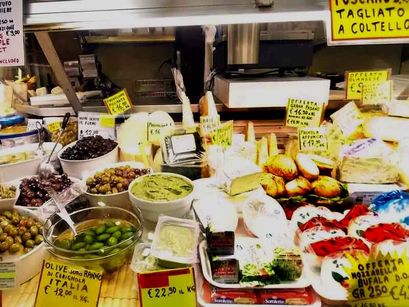 Nothing special... Just a typical display in a local alimenari! Nothing special... Just a typical display in a local alimenari! Getting used to Shopping in Italy At times we bought food at the large supermarkets, which had great cheese displays, not so decent breads, un-refrigerated milk in cartons (none cold), but lots and lots of produce. The fruits and veggies were very good for supermarkets, but the tomatoes disappointed me. They seem to be selling a lot of hybrid hothouse grown tomatoes (like "Tomatoes on the Vine" in the U.S.). Decent quality, but not organic, fresh picked or heirloom varieties. (As it turns out, Italians use SO MANY tomatoes in their diet, factory farmed tomatoes are the norm, although smaller markets may have Heirloom types). 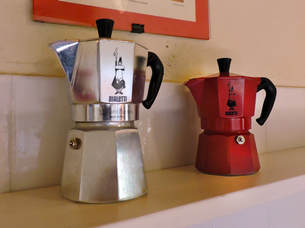 Great cheeses were something we could get anywhere--supermarket or alimentari. Amazing. Cacciacavalo became our favorite... a dumbbell shaped cheese with mellow, nutty flavor which went with everything. Any type of aged Pecorino was a close second. One of my favorite things became the millefiore honey... thick as jam and incredibly delicious on bread in the morning. It was also great with ricotta. (I was never really a fan of American style honey.) Lisa also fell in love with making coffee (espresso, scusa me) in those little Moka pots. I'm sure Santa will leave one under the tree for her. I wish I had access to a pizza oven while in Italy. I would have loved to make pizza there... but heck, I discovered that I make pizza better than we had in most of Italy anyway. Cooking for ourselves in Italy became one of our favorite things, although Lucas always liked eating out in a new ristorante no matter where we were. Personally, I think he was starting to realize that if we ate out, he was guaranteed a visit to a gelateria afterwards! --Jerry Finzi |
Archives
May 2024
Categories
All
|

